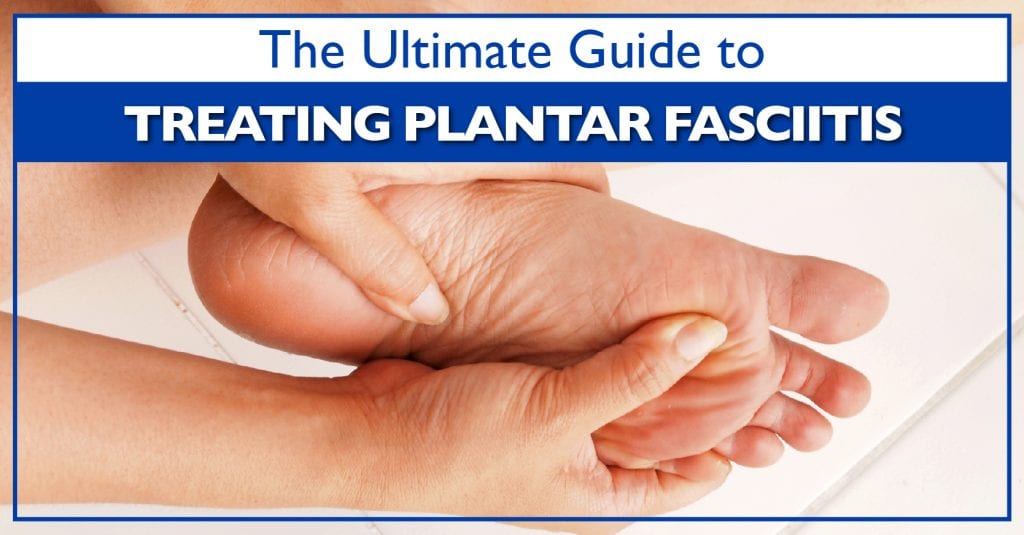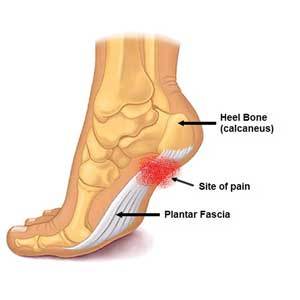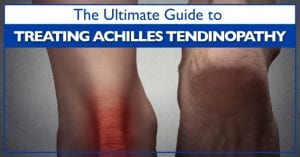
What is the Plantar Fascia?
The plantar fascia is a thick, fibrous band of connective tissue. Its origin is the medial surface of the heel, running along the sole of the foot like a fan, being attached at its other end to the base of each of the toes.
It is a tough, resilient structure that has a number of critical functions during running and walking:
> It stabilises the metatarsal joints during impact with the ground.
> It acts as a shock absorber for the entire leg.
> It forms the longitudinal arch of the foot and helps to lift the arch to prepare it for the ‘take-off’ phase of the gait cycle.
A force equal to almost 3 times your body weight passes through the foot with each step. On running, this is much higher and typically happens 90 times a minute.
Plantar Fasciitis

Plantar Fasciitis is thought to be a degenerative process rather than inflammatory due to damage of the plantar fascia in the form of micro-tears due to overuse.
Damage tends to occur near the heel, where stress on the fibres is greatest, and where the fascia is the thinnest. The fascia broadens as it extends towards the toes.
Plantar Fasciitis is often associated with calcaneal spurs. These are depositions of calcium where the fascia suffers most damage.
Signs & Symptoms:
1. Painful to walk first thing in morning
2.Feet are painful after standing, walking, running, specifically in the Plantar Fascia origin
3.Some Shoes are better than others
4. Tender on the sole of the foot closest to the heel.
Risk Factors / Causes:
1. Over Weight Increases the risk.
2. Flat Feet (Pronation Distortion Pattern)
3. Loss of Ankle Mobility
4. A sudden increase in training load
5. Poor Footwear
Treatment of Plantar Fasciitis
Initial Plan:
1.No Barefoot Walking
2.Wear Orthotics
3.Before Moving after rest – write the alphabet with your foot in mid air.
4.No Running
5.Find a Local Supplier of Shockwave Therapy
Self Assessment:
So once you’ve taken care of the initial plan its time to assess yourself to figure out whats
causing your problem and what areas to focus on in your efforts to treat plantar fasciitis
and to prevent it coming back.
1. Foot Posture
If your feet look like this:
Then you need orthotics. Before you do anything else go see a local podiatrist or orthotist.
If your feet are a little less extreme then you may get away with not having orthotics, but in both cases you will want to do these following exercises to strengthen up your foot arches and work on the stability of your foot and ankle.
Fix 1. Towel Grab
Fix 2. 1 Leg Balancing
Fix 3. 1 Leg Toe Taps
2. Big Toe Extension
Do these tests to determine 1. If you lack big toe extension 2. If its due to joint immobility or soft tissue restriction.
If you lack big toe extension, as you walk you’ll roll your foot into over pronation to compensate for the lack of mobility. This is usually one of the biggest causes of bunions.
Fix: Joint Restriction – Calf Raises with big toe extension
Fix: Soft Tissue Restriction – Calf Stretches
& Plantar Fascia Rolling
3. Ankle Mobility
Do this test:
While doing the knee to wall test, if you have over 10cm then its good, 6cm or less is bad. Also look for symmetry between feet As above, if you lack ankle mobility, your compensatory pattern is to over-pronate.
Fix: Ankle Mobility Restriction – Knee Wall Tests
Fix: Ankle Mobility Restriction – Ankle Mobilisation
Fix: Soft Tissue Restriction – Calf Stretching
4. Pelvic Stability / Pronation Distortion Pattern
Is your problem from further up? Do you lack hip stability and glute strength that you cant control the biomechanics of the lower limb. Does your knee fall inwards? Tibia Internally Rotate? Feet Drop in and over pronate?
Have a look at this picture and compare it to yourself.
Fix: Clams
Fix: Side Lying Leg Raises
Fix: Side Plank
Fix: Monster Band Walks
Fix: 1 Leg Squats
Fix: Bulgarian Split Squats
5. Glute Strength (or Weakness)
Following on from the previous point, are your gluten weak so that it allows the above posture to occur?
Test 1: Glute Bridge 60 seconds
Test 2: 1 Leg Glute Bridge 30 seconds
Summary
If you are suffering with plantar fasciitis or even if you are not currently but noticed that you have flat feet or worse, the pronation distortion pattern shown above, then this is what your are going to do:
Initial Plan:
No Barefoot Walking Until Pain Free
Wear Orthotics
No Running until you can walk pain free.
Get Some Shockwave Therapy
Week 1
Roll Your Feet with a Tennis Ball / Spiky Ball 1-2 minutes per foot each day
Stretch Your Calves (Gastroc / Soleus) 6 times per day for 1 minute each
Week 2
Continue with above but add in:
Big Toe Extension
Ankle Mobility
Week 3 & 4
Move into strengthening:
Towel Grabbing for 2 minutes twice per day
1 – Leg Balancing 1 Minute per side each day
Week 5 & 6
Glute Strengthening: Glute Bridges / Clams / Side Planks / Monster Band Walks
Eccentric Calf Raises:
Up on 2 and Lower on 1 (3 x 15)
6 second decent.






